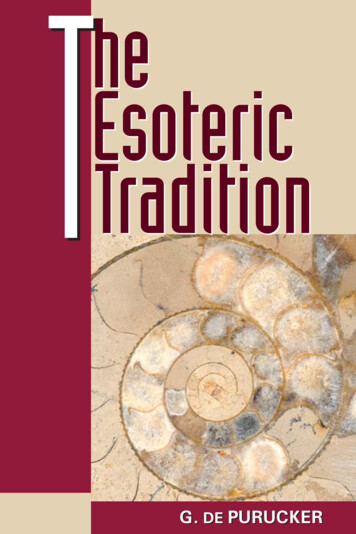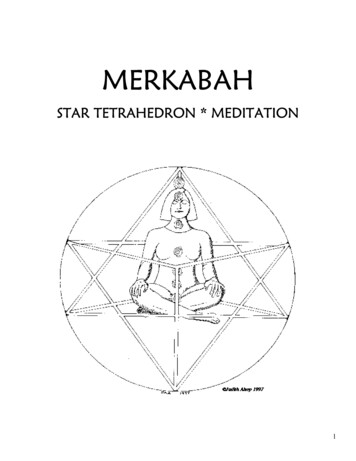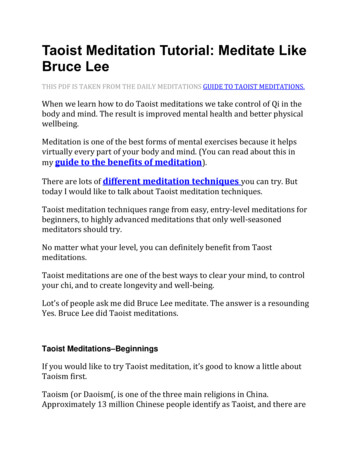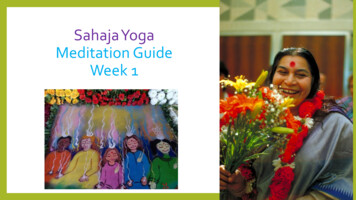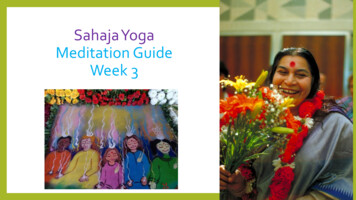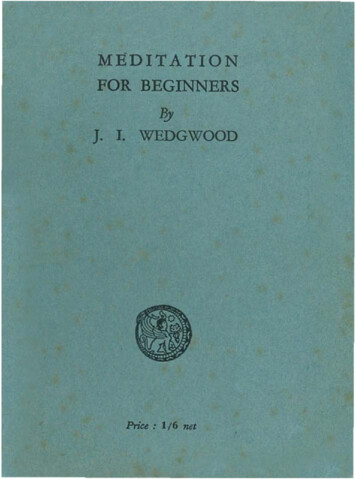
Transcription
MEDITATIONFOR BEGINNERSByJ.I. WEDGWOODPrice : 1!6 net
MEDITATIONFOR BEGINNERSByJ.I. WEDGWOODThe Theosophical Publishing House, London, Ltd.68 Great Russell StreetLondonW.C. I
Third EditionRevised and Enlarged 1918Reprint1919Reprint1926Reprint1951Princcd in Gre: t Britain by John Bellows Ltd., Gloucester510216
Withdraw into yourself and look. And if you donot find yourself beautiful as yet, do as does the creator ofa statue that is to be made beautiful; he cuts away here,he smooths there, he makes this line lighter, this otherpurer, until he has shown a beautiful face upo11 thestatue. So do you also; cut away all that is excessive,straighten all that is crooked, bring light to all that isshadowed, labour to make all glow with beau9', and donot cease chiselling your statue until there shall slnneout on you the godlike splmdour of virtue, until you shallsee the final goodness surely established in the stainlessshrine.Plotinus on the Beautiful(Translated by STEPHEN MAcKENNA)
James Ingall Wedgwood]ames lngall Wedgwood was born in London in1883 and died in Famham in 1951. He was a memberof the well-known T1-'edgwood family that has for somegenerations distinguished itself in art, in science, inindustty and in other braTlches of public service. JVhma young man he studied church music and organ construction and later received the degree of Docteur (Sciences)de l'Universite de Paris for a textbook on this subJectwhich is still used. In 1904, deeply influenced by alecture of Dr Besant's, he Joined the Theosophical Socieg,becoming General Secretary of the English Section in191 r. In I 9 I 6 he was consecrated as the first Bishopof the Liberal Catholic Church, a movement devoted toliberalizing Christian thought, which he did much tofoster.This reprint of his small but invaluable book onmeditation had been planned before his death. Thosewho are responsible know that his many frierzds wouldnot wish it to appear at this moment without some smallrecognition of the debt owed to him by students andaspirants througlwut the world. Its publication is onlyone of the many tributes that will continue to be paidto him, in appreciation of what he has given not only tothose who knew him, but to all mankind.London, M ay, 1951.
MEDITATION FOR BEGINNERST is significant of the spiritual tendency of theTheosophical Society that there is a steadyinterest in meditation, and many now desirehelp and guidance as to its practice. Within theInner Section of the Theosophical Society (calledthe Esoteric School) very definite and helpfulinstruction is available for earnest and approvedstudents; but there are many who, perhaps fordomestic or other reasons, do not feel free to undertake the heavy responsibility implied in joiningthis- for to enter the Esoteric School implies thatTheosophy is thenceforward to become a dominantfactor in the life. Such members often wish tolearn how to meditate, and it is with the hope ofaiding this large class of earnest and spirituallyminded people that these present suggestions areput forward. Also, it may be pointed out, it isonly possible to gain admission to the EsotericSchool after three years' membership in the outerSociety, and during this preliminary period muchof the necessary spadework may be accomplished,I
6.Nfeditation for B eginnerswith the result that the aspirant will be betterfitted for the training of the Inner Section and ofgreater service to its corporate life.The present hints are written more especiallyfor Theosophists, although they may be foundhelpful by others who have not yet embraced thephilosophy of life summed up under the name ofTheosophy. This course has been followed quiteadvisedly, for the author believes that it is of littleuse to set to wor.k upon the serious practice ofmeditation until the teachings regarding the control and use of thought and emotion set forth inTheosophical books have been mastered, and untilthe aspirant has emerged from the dilettante stageof occultism. Until then he will derive morebenefit from quiet reflection upon devotional booksor from the practice of the earlier methods laiddown in the various exoteric religions. For moreadvanced students, following other methods ofstudy, the author does not profess to write.WHAT MEDITATION ISMeditation consists in the endeavour to bringinto the waking consciousness, that is, into the mindin its normal state of activity, some realisation of
Meditation for Beginners e7s!:!Per.:. 2nsciousness, to create by the power ofaspiration a channel through which the influence ofthe divine or spiritual principle-the real manmay irradiate the lower personali ISthereaching out of the mind and feelings towards anideal, and the opening of the doors of the imprisoned lower consciousness to the influence of thatideal. ' Meditation,' says H. P. Blavatsky, ' is theinexpressible longing of the inner man for theInfinite.'-- The ideal chosen may be abstract-it may be avirtue, such as sympathy or justice; it may be thethought of the Inner Light, of that Divine Essencewhich is the innermost reality of man's nature: itmay even be recognised only as a vague and dimsensing of the highest that is in us. Or the idealmay be personified as a Master, a Divine Teacher-indeed it may be seen as embodied in anyonewhom we feel in any way to be worthy of ourrespect and admiration. Consequently the subjectand type of meditation will vary v.1dely accordingto the temperament and 'ray' of the individual.But in all cases it is essentially the uplifting of thesoul towards its divine source, the desire of theparticularised self to become one with the Gniversal Self.
8Meditation for Begin11ersFIRST STEPSThe first steQ in meditation consists in cultivatingthe thought, until it becomes habitual, that thephysical body is an instrument of the spirit.T hose who have only just made the acquaintanceof Theosophical thought find it difficult at first toreverse their point of view; to them the soul andspirit are unreal. The planes and bodies, of whichT heosophical writers speak in their endeavour toconvey clearly and with scientific precision somelittle glimpse of the mysteries of man's being, arememorised in terms of some text-book diagram,each name being conjured up with an effort ofmemory. The physical body is the one tangiblereality and the superphysical the shadowy andvague, a mere intellectual conception. But gradually and almost imperceptibly this feeling is lost; afeeling of realisatior1 of the superphysical begins towork down into the physical brain and to enlivenwhat was previously merely an intellectual theory.The reason for this is not far to seek. To readTheosophical books is to place oneself in touch withpowerfully stimulating forces in the world of mentalarchetypes; to read of higher bodies tends by
Meditation for Beginners9directing the attention to those bodies to awakenself-consciousness in them. Interest in and studyof the astral})Iane and the astral body graduallywaken the student on that plane during physicalsleep. The stimulation of the higher bodies intogreater activity is also assisted by being within theaura of superphysically developed people. As anatural result this expansion of the inner naturebegins to modify the waking consciousness, theknowledge of the Higher Man slowly filters downinto the physical brain, and the student will findhis outlook on life undergoing great change. Anextension of consciousness becomes noticeable, newvistas of thought and feeling open up before him,his surroundings in life assume a fresh significanceas he awakens to them, and the truths ofTheosophybegin to change from intellectual theory intospiritual experience.Such, briefly stated, is the rationale of thegradual expansion of consciousness, which comeswithin the early experience of most Theosophistswho are really in earnest; and we may, in passing,hazard the idea that the three years that mustelapse before a student is eligible for the EsotericSchool are prescribed not only that his steadfastness in Theosophy may be tested, but also that
10Meditation for Beginnerstime may be allowed for this change in the superphysical bodies, through which he may comeintuitively to feel himself as the Higher Man usinga physical instrument.Now this process of expansion and awakeningmay be materially quickened. ' Help Nature,'says The Voice of the Silence, 'and work on with her;and Nature will regard thee as one of her creatorsand make obeisance.' A modern scientific writerhas echoed the same truth in the words ' Nature isconquered by obedience ' ; we have but to understand the laws of nature, and then, rightly selectedand applied, they become our obedient servants.That which takes place slowly and gradually in theordinary course of time may be deliberatelyhastened by intelligent and well-directed effort.Hence the student's first exercise in meditationmay fittingly have in view this aim of consciouslyrealising the Higher Man.The following practice is one which the presentwriter employed with good results, until it becameunnecessary to continue with it.MEDITATION ON THE BODIES. Let the studentbegin by thinking of the physical body; thenconsider how it is possible to control and direct it,and thus separate himself in thought from it-
Meditation for BeginnersI Iregarding it as a vehicle, and picture himself for afew moments as living in the astral body. Let himreflect, in turn, that he can control his emotionsand desires; and, with a strong effort, repudiatethe astral body and realise that he is not this bodyof surging and struggling passions, desires andemotions. Then let him picture himself as livingin the mental body; and reflect again that he cancontrol his thoughts, that he has the power ofsettinghis mind to think on any subject he pleases, andagain with an effort repudiate the mental body.The student should now let himself soar into thefree atmosphere of the spirit where is eternal peace,and, resting there for a period, strive with greatintensity to realise that That is the real Self.Let him now descend again, carrying with himthe peace of the spirit through the different bodies.Let him picture the aura of the ental body rayingout around him, and let the influence of peacesuffuse it, as he affirms that he is the Self whichuses the mental body as an instrument in hisservice. Then descending into the astral body,again let the peace ray out through the aura, as heaffirms that he is that which uses the emotions ashis servants; and lastly, let him return to thephysical body, recognising it as an instrument, and
12Meditation for Beginnersas a centre of the divine peace, wherever it maypass in the world.The exercise may at first seem strange and fruitless, for the physical body is still the great reality,and thought and feeling are still apt to be regardedas products of the physical brain. The beginnermust remember that he is seeking to undo thethought-habit of years, and therefore must not beimpatient for immediate results. Possibly muchtime may elapse before his intuition assures himwith unerring certainty that there is a higherpower within him, guiding his actions and shapinghis course through life. Quite naturally, he maydread the possibility of self-hypnosis, the thoughtthat he may by slow degrees be deluding himselfinto beliefs which are fanciful and have no foundation of reality. To the well-balanced mind theearlier stages are by far the most difficult, for thereis a natural caution about venturing into theunknown, a nd a tendency to beat a mental retreatat each suspicion of danger. None the less, it isonly reasonable to give due trial to a systemexpounded by the greatest minds of antiquity,prescribed in all the great religions and witnessedto by eminently sane and sincere people of thepresent day. And a little steady and persistent
Meditation for Beginners13practice is bound to lead to certain results. Howdefinite those results will be and with what degreeof rapidity they will be apparent will naturallydepend upon the temperament, the industry andthe possibilities of the individual.A MORE ELABORATE FORM OF THE ABOVE. Asthe beginner grows more familiar with the meditation outlined above, he may begin to elaborateit, according to the bent of his temperament. Hemay find it helpful, for instance, to consider thesimile of a pianoforte and a pianist. As thepianoforte produces sound and ordered music, sothe brain and physical body give expression tothought, feeling and ordered activity. But it isthe pianist who expresses himself through themedium of the instrument. In the same way thephysical body (in its voluntary activities) does butvibrate in response to the Higher Man.Detaching himself in thought fi·om the physicalbody and examining it in the cool discriminationof the mind, he should endeavour to realise that itis only a vehicle, an instrument, a vesture of flesh.In order that the consciousness, which is themanifestation of the spirit, can contact the physicalworld it must inhabit a tabernacle of physicalmatter, kith and kin with that physical world, for
Meditation for Beginnersonly a physical vehicle of consciousness can makevibratory relationship with physical matter. Bythe multiplicity of experiences to be gained fromthe physical world and the gradual shaping of thephysical instrument to respond to them, the spiritunfolds its innate powers from latency into potency.He may then consider how it is possible to control and direct it, how it responds to the behests ofthe governing intelligence-the I. Thus separating himself in thought from it, he should nextp icture himself for a few moments as living in theastral body.Let him reflect, in turn, that the astral body isnot his real self. He can control his emotions andd esires, he can regulate the play of feeling. Hisemotions are but one aspect of his consciousnessworking in and limited by the astral body, which,in its turn, is a tenement built up from the materialof the astral plane, that the indwelling consciousness may come into relation with it. He himself isnot this body of struggling, surging emotions,passions and desires. In his calmer moments heknows that he is above the surge of emotions.H is fits of passion, of jealousy, of fear, of selfish nessand hatred- all these are not himself but the playof emotions which have slipped beyond control, as
.\lfeditation for Beginnersa greyhound may slip his leash. In his heart ofhearts he knows that as much of this is alreadyunder his control, so by dint of patient perseveranceand earnest endeavour all may in course of time bebrough t within due bounds, and mastery of theemotions be gained .Thus standing as it were outside of his emotions,looking down upon the whole sphere of theiractivity, let him next picture himself as living inthe mental body.It is not difficult for the beginner to separatehimself from his physical and emotional bodieshe has been taught in the practice of ordinarymorality to check and control actions and violentemotion; but he has probably never been taughtm uch of the power of thought, and accordingly hefinds it difficult to realise at first the possibility ofcontrolling his thought.Yet he has the power to set his mind upon anysubject he pleases, and by d int of perseverance hemay learn to keep it fixed thereupon. Andeventually he may gain such control of the mindas to be able to d ismiss from it at will any unwelcomethought.And so, passing through the various stages, hemay raise himself into the contemplation of T ha t
16Meditation for Beginnerswhich is beyond words, ineffably real and sacred,reaching the very shrine of his own being, the altarupon which the Divine Shekinah itself is mademanifest, and bearing with him that radiance intothe outer world of sense.When the student by his meditation and by hisoft-repeated thought during the day has grown toregard himself as the Inner Man, working outwards into the world through the instrumentalityof a physical body, he may then pass on to moreelaborate and scientific forms of meditation. Heshould begin to work with fuller understanding ofits various details and stages, regarding it as atonce a means of spiritual refreshment and growthand a science of wrestling with the wayward mindand feelings.cm CENTRATIO.c\Meditation is often divided into three stages:Concentration, Meditation, Contemplation. Itmay be still further sub-divided, but it is unnecessary to do so here; on the other hand thebeginner should bear in mind that meditation isa science of a life-time, so that he must not expectto attain to the stage of pure contemplation in hisearlier efforts.
Meditation for BeginnersConcentration consists in focussing the mind onone idea and holding it there. Patanjali, theauthor of the classic Hindu Yoga AjJitorisms, definesYoga as ' the hindering of the modifications of thethinking principle.' This definition is applicableto concentration, though Patanjali probably goesfurther in his thought and includes the cessation ofthe image-making faculty of the mind and of allconcrete expressions of thought, thus virtuallypassing beyond the stage of mere concentrationinto that of contemplation.To be able to concentrate, then, it is necessaryto gain control of the mind and learn by gradualpractice to narrow down the range of its activity,until it becomes one-pointed. Some idea orobject is selected upon which to concentrate, andthe initial step is to shut out all else from the mind,to exclude therefrom the stream of thoughts aliento the subject, as they dance before the mind likethe flickering pictures of the cinematograph. Itis true that much of the student's practice must inthe initial stages take this form of repeated exclusion of thought; and to set oneself to do this isexcellent training. But there is another and farsounder way of attaining concentration; it consists in becoming so interested and absorbed in the
Jvleditation for Beginnerssubject selected that all other thoughts are ipsoWe are constantlydoing this in our daily lives, unconsciously and byforce of habit. The writing of a letter, the addingof accounts, the taking of weighty decisions, thethinking out of difficult problems- all these thingsso engross the mind as to induce a state of more orless wrapt concentration. The student mustlearn to accompl ish this at will, and will bestsucceed by cultivating the power and habit ofobserving a nd paying attention to outer objects.Let him take any object- a penholder, a pieceof blotting paper, a leaf, a flower- and note thedetails of its appearance and structure ·whichusually pass by unnoticed; let him catalogue oneby one its properties, and presently he will findthe exercise of absorbing interest. If he is able tostudy the process of its manufacture or growth, theinterest will again be heightened. No object innature is in reality entirely dull and uninteresting;and when anything seems so to us, the failure toappreciate the wonder and beauty of i ts manifestation lies in our own inattentiveness.As an aid to concentration, it is well to repeataloud the ideas that pass through the m ind. So:this penholder is black; it reflects the light fromfacto excluded from the mind.
Meditation for Begirmersthe window from some portions of its surface; itis about seven inches in length, cylindrical; itssurface is engraved with a pattern; the pattern isbranch-shaped and is formed of a series of closelymarked lines-and so forth ad libitum.In this way the student learns to shut out thelarger world and to enclose himself in the smallet·world of his choice. When this has been donesuccessfully he has achieved a certain degree ofconcentration- for it is evident that there are stillmany and various thoughts running through themind, though all on the subject of the penholder.The speaking aloud helps to slow down this streamof thought and to hinder the mind from wandering.Gradually by practice he learns to narrow downstill further the circle of thought until literally hecan reach one-pointedness of mind.The above practice is somewhat in the nature ofdrill instruction; it requires a degree of strenuousapplication, and, moreover, may appear somewhatcold to the student, since it arouses little emotion.Another exercise in concentration may thereforebe taken concurrently, but before describing thiswe may say that the former exercise must needs bemastered at some stage of the student's career.Some degree of mastery therein is a preliminary
20Meditation for Beginnersto successful visualisation- that is, the power ofmentally reproducing an object in accurate detailwithout it being visible to the eyes-and accuratevisualisation is a necessary feature of much of thework which is done by students trained in occultmethods such as the deliberate construction ofthought-forms and the creation of symbols by themind in ceremonial. Accordingly the studentwho is really in earnest will not neglect this branchof work on account of it being difficult and requiring application. He will also set to work atvisualisation, observing and carefully scrutinisingan object, and then with the eyes closed endeavouring to build up a mental picture of it.The second method, above referred to, is that ofconcentrating not upon a physical object but uponan idea. If some virtue be taken it has theadvantage of arousing the enthusiasm and devotionof the student, and this is a very important consideration in the initial stages of his practice, whenperseverance and steadfastness are often sorelytried. Moreover, the effort builds that virtueinto the character. In this case the concentrationis chiefly that of the feelings and less conspicuouslya mental process. The student strives to reproduce in himself the virtue, let us say sympathy, at
,\1.editalion for Begi1mers21which he is aiming, and by dint of holding himselfto a single emotion, by the power of the willeventually succeeds in feeling sympathy. It iseasier to l;le one-pointed in feeling than in thought,for the latter is more subtle and active; but ifintense concentration of feeling can be induced,the mind will to a certain extent follow suit. EDITATIONHaving thus considered concentration we cannow pass on to the second main division of oursubject- namely, meditation. Meditation is theart of considering a subject or turning it over in themind in its various bearings and relationships.Properly speaking, the stage of meditation does notfollow directly upon the complete one-pointednessof mind which we have discussed above, it rathersucceeds that stage of comparative concentrationwhich has banished from the mind all ideas aliento the one subject under consideration; butefficiency in concentration will be required as eachbranch of the meditation is taken up. We neednot occupy space with further definitions ofmeditation, but may at once pass on to certainschemes of practice which will illustrate its nature
22Meditation for Beginnersand method more clearly than theoretical dissertation. We have touched above on the thoughtof sympathy and may well use it as a subject ofmeditation.MEDITATION ON SYMPATHY. Reflect that like allother virtues this is an attribute of the DivineConsciousness; try to understand its nature andfunction in the world; consider it as a bindingpower uniting one particularised self to another.Compare it with love: sympathy implies understanding of another and the power to place one'sself in his position; love need not imply thisunderstanding, it may consist only in the intensedesire to give one's self to another, though it ismore perfect when united with a sympatheticunderstanding; on the other hand for its completeexpression sympathy requires the strong innermotive power which love alone can supply.Picture the divine sympathy as poured forth intothe world through the ideal man- the Christ orthe Master- and then as directed towards one'sself individually.The student should then with a strong activeaspiration merge himself into the stream of thisineffable influence radiating from the Master, andso seek to reach the object of his devotion. (Here
/v.feditation for Beginnersthe stage of contemplation may be attained) . Heshould then think of this virtue as applied in hisdaily life, to his fi·iends and loved ones- even tothose with whom there is need for better understanding; let him picture them one by one beforehim and wrap them round with the influencewhich is pouring through him.Another and more elaborate meditation maybe given for the benefit of those who are unable todwell for any length of time on a single thought.MEDITATIONTOEXPANDTHECONSCIOUSNESS.The student should raise his consciousness andcontemplate the immensities of the universe; thepicture of the star-lit heavens, the soft radiance ofthe sunset, or the thought of the cosmos enshrinedwithin the infinitesimally minute atom, will aidhim in this, and he may, if he so desire, use themethod of rising through the bodies describedearlier in this book. Let him then direct histhoughts in loftiest aspiration to the Logos of oursystem and picture the whole system as containedwithin the bounds of His consciousness: ' In Himwe live and move and have our being'. He maythen follow out the line of thought developed inthe pamphlet by Mrs Besant entitled On Moodsnamely, that though we might naturally think of
Meditation for Beginnersthe loftier members of the Hierarchy as being mostdistant from us and almost beyond the reach of ourhalting aspiration owing to their remoteness frompetty human interests, the reverse is actually true,and we are literally in closest touch with the allembracing consciousness of the Logos. The studentmay find it helpful to think of the increasing sizeofthe aura as spiritual development is achieved;of that of the ordinary man, of that of pupils andinitiates, of the aura of the Master and the closerelation of consciousness between the Master andhis pupils and others whom he is helping, of theaura of the Lord Buddha which according totradition extended three miles about His person,and so rising in thought he may conceive of abeing whose aura or field of consciousness encompasses the whole of our planet and of One who thusembraces the whole of the system to which webelong. Literally is it true that every action,every feeling and every thought to which we giveexpression are part of Him; nay, our very memoryis part of His memory, for is not all remembrancebut the power to touch the akashic records ofnature, which is but the expression of Himself?The student may then pass on to think of someof those qualities which we may associate with the'
lvfeditation for Beginnersmanifestation of God in His world- let us takejustice and beauty and love; that the justice ofthe Supreme is shown forth in the invariable lawsof nature, the law of the conservation of energy,the dictum of Newton that action and re-actionare equal and opposite, the law of karrnic retribution which gives unto each man the just rewardof his deeds. Let him think of what belief inkarma really implies- the hand that strikes agrievous blow is one's own dead past come back tolife again; and from such reflections let him wincontent with that which is or which may befall him.Let him think also of the innumerable relationsunder this law made between man and man, theweaving of God's plan in the universe, and see inthose complex relationships the immutable lawof perfect justice.Passing next to the aspect of beauty he maystudy the exquisite plan of the Great Architect andGrand Geometrician of the Universe, and lookingwith closer attention at all created nature mayperceive the universality of that aspect of theSupreme which expresses itself in beauty orharmony. Turning from beauty of nature to thatcreated by man he may soar aloft on the wings ofthe imagination and contemplate the masterpieces
Meditation for Beginnersof that human art which borders on the realm ofdivinity, because in very truth the materials in thehand of the artist are the divine powers of nature.Thus, in music, the mighty structures of soundreflect in many hues those archetypal forces ofnature which stream forth through the blazinghosts of the Gandharvas, revealing to man thepower of the hidden Word and raising him aloftonce more to the kingdom of his divine heritage.And in the compassionate love of the Supremeall human relationships of tenderness and lovehave their source. To the eye of the spirit thebeauty of woman gives no cause for carnal desire,but is rather a reason that she should be respectedas a child of God and a manifestation of Hissupreme beauty. There is but one love throughout the universe, given by the Divine Father intothe custody of His creatures; it is the one primalforce which in its elementary creative aspectproduces multiplicity of form and in its higheraspect draws souls together towards unity in theOne Life.CONTEMPLATIONTo the beginner attempting the foregoingmeditations they will at first probably appear little
Meditation for Beginnersmore than intellectual exercises, more or lessinteresting according to the bent of his temperament and capable of arousing a certain degree offeeling. But as he perseveres in his efforts andenters more into the wonder and beauty of thegreat concepts he is considering, he will graduallyacquire something of that personal spiritualexperience which spans the gulf between the manof k,nowledge and the man of wisdom, and he willattain to some realisation of that inner peace andexaltation of the soul, of which St. Alphonsusde'Liguori speaks when he describes meditationas ' the blessed furnace in which souls are inflamedwith Divine love'. For meditation harmonisesthe bodies in which we work, enabling the light ofthe spirit to shine down and illurnine the darkrecesses of our waking consciousness. It stills theturmoil of our personalities-the mind, theemotions, the restless activity of the brain-and byreason of the synchronous vibration of the lowerbodies enables the ego to influence the personality.A
MEDITATION FOR BEGINNERS IT is significant of the spiritual tendency of the Theosophical Society that there is a steady interest in meditation, and many now desire help and guidance as to its practice. Within the Inner Section of the Theosophical Socie

